|
|
ARTHROPODS:
Insects»
Spiders»
Centipedes»
Millipedes»
Sowbugs»
Harvestmen»
Mites
& Ticks»
Scorpions»
Identification
Tips»
About
the Critter Files»
Links» |
|
|
|
 |
LYGAEOIDS
Seed
Bugs and Their Kin
Critter
Files/Insects/True
Bugs/Lygaeoids (Seed Bugs & Kin)
By Blake Newton
University of Kentucky Department of Entomology |
| |
|
| |
| TAXONOMY |
KINGDOM:
Animalia | PHYLUM: Arthropoda | CLASS: Insecta | ORDER: Hemiptera
| SUPERFAMILY: Lygaeoidea | FAMILIES: Lygaeidae, Rhyparochromidae,
Blissidae, Berytidae,
Geocoridae, Pachygronthidae, etc. |
| |
WHAT
IS A LYGAEOID?
LIFE CYCLE
ECOLOGY
PEST STATUS
COMMON KENTUCKY LYGAEOIDS
COLLECTING & PHOTOGRAPHY
LYGAEOID FACTS
MYTHS, LEGENDS, AND FOLKLORE |
| |
| WHAT
IS A LYGAEOID? |
|
Lygaeoids
are a group of insects in the superfamily Lygaeoidea, which belongs
to the insect order Hemiptera. The order Hemiptera also includes
assassin bugs, stink
bugs, plant bugs, leaf-footed bugs, and many
other insects. All insects in Hemiptera share several characteristics,
including piercing-and-sucking mouthparts, and wings which are membranous
at the tips, but hardened at the base.
The superfamily Lygaeoidea
includes about 15 families. The members of some of these families
are called "seed bugs," but there are many other
common names as well, including Big-Eyed Bugs (family Geocoridae)
and Stilt Bugs (Berytidae). Together, all of these insects
are referred to as "lygaeoids," from the name of the superfamily,
Lygaeoidea. |
| |
| CONFUSING
NAMES
Until about 10 years ago, most of the insects listed on this page
were considered part of the same family, Lygaeidae, and all were
called "seed bugs." Scientists recently broke the
family Lygaeidae into several smaller families, including Lygaeidae (milkweed
bugs and their relatives), Rhyparochromidae (which contains the
long-necked seed bugs and their kin), Blissidae (chinch bugs and
kin), Geocoridae (big-eyed bugs) and Pachygronthidae (contains
the Oedancala genus). All of these families
were then placed in the superfamily, Lygaeoidea, along with a few
other families (like Berytidae, the Stilt Bugs).
Although
the new family names reflect a more accurate picture of the relationships
between these insects, the changes can be confusing, especially
because many field guides, websites, and entomology textbooks still
treat these groups as a single family. According to Hemiptera
experts, the family Rhyparochromidae contains the only "true"
seed bugs, although many insects in the other families listed on
this page are sometimes called "seed bugs."
To further add to the
confusion, there is an insect called the "Western
Conifer Seed Bug," Leptoglossus occidentalis,
which belongs to the family Coreidae (Leaf-footed
Bugs). It doesn't belong to any of the families on this
page.
Visit this page
from the Australian Faunal Directory to read more about the
superfamily Lygaeoidea and the families that it contains. |
| |
There are
many body shapes, sizes, and colors represented in the Lygaeoidea
superfamily, but they have a few things in common. Many lygaeoids
are relatively slender with subdued color patterns, but several
common species are brightly colored. Lygaeoids are easily
confused with members of other Hemiptera groups, especially plant
bugs (family Miridae) and leaf-footed
bugs (family Coreidae).
The best way to identify
most lygaeoids is to examine the veins in the membranous portion
of the outer wing. In most lygaeoids, there are only 4 or
5 simple veins here, while other types of hemipterans have a different pattern.
This is not true for lygaeoids in the family Berytidae (the
Stilt Bugs), but insects in Berytidae are unlikely to be confused
with any other bugs. |
| |
 Wing
of a typical lygaeoid: roll mouse over the wing to
Wing
of a typical lygaeoid: roll mouse over the wing to
highlight the distinctive vein pattern (B. Newton, 2006) |
|
DISTINGUISHING
BETWEEN LYGAEOID FAMILIES
A microscope and a detailed scientific key (such as the key to the
families of Hemiptera found in the 2004 edition of the Introduction
to the Study of Insects by Borror and Delong) is need to accurately
distinguish the different lygaeoid families, genera, and species from one another. However,
the most common members of each family are pictured below, and with
a little practice they can be recognized without a microscope. |
| |
| SIZE:
Body lengths up to about 3/4" long |
| |
| LIFE
CYCLE |
|
Like
all Hemiptera, lygaeoids go through a simple metamorphosis with
egg, nymph, and adult stages. During warm months, most female lygaeoids
lay eggs on plants or insert eggs into plant tissue. The eggs
hatch soon afterward. Lygaeoid nymphs look like small, wingless
versions of the adults. As they grow, the nymphs molt (shed
their skins) several times before turning into full-grown adults.
Most lygaeoids spend the winter as adults or large nymphs.
|
|
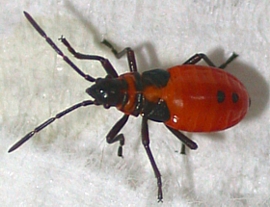 Nymph
of a Milkweed Bug, family Lygaeidae (B. Newton, 2005)
Nymph
of a Milkweed Bug, family Lygaeidae (B. Newton, 2005) |
| |
| ECOLOGY |
|
Most lygaeoids
are herbivores that use their mouthparts to suck fluid from plants
and seeds. Some of these plant-feeding species are "generalists"
that feed on a wide variety of plants, while others (like milkweed
bugs) are "specialists" that feed on only a few species.
Some lygaeoids, especially the Big-Eyed Bugs (family Geocoridae)
are predators that live on low-growing plants where they capture
and eat aphids, caterpillars, and other insects. In Kentucky,
lygaeoids are found in agricultural habitats, gardens, fence-rows,
the forest edge, and any place that is sunny with low-growing vegetation.
Lygaeoids are sometimes prey for spiders, assassin bugs, birds,
and other creatures, but most lygaeoid species receive some protection from predation because of
foul-tasting, defensive chemicals that they receive from their food
plants. |
| |
| PEST
STATUS |
|
Although
some lygaeoids are predatory and are considered beneficial, a few
of the plant-feeding species are serious pests. In particular,
the Chinch Bug, Blissus leucopterus, is sometimes a serious
pest of grain crops and in lawns. Read more about pest chinch
bugs and their control at this Ohio State University factsheet:
http://ohioline.osu.edu/hyg-fact/2000/2503.html |
| |
| COMMON
KENTUCKY LYGAEOIDS |
|
|
MILKWEED
BUGS
FAMILY: Lygaeidae
| GENERA: Oncopeltus, Lygaeus
In Kentucky, the most
well-known members of the family Lygaeidae are the Milkweed
Bugs. There are two common milkweed bugs in Kentucky.
Both are sometimes found in large numbers feeding on the sap
of milkweed plants in the summer and fall in Kentucky. Milkweed
sap is toxic to most organisms, but milkweed bugs are immune to
the poison and store it in their bodies to protect against predators.
The Large Milkweed Bug, Oncopeltus fasciatus,
shown below, is about 3/4" long with a bold black-and-red color
pattern. Not pictured is the Small Milkweed Bug, Lygaeus
kalmii. It is about 1/2" long, but is otherwise
similar to the large milkweed bug in appearance and behavior. A
milkweed bug nymph is pictured above. |
| |
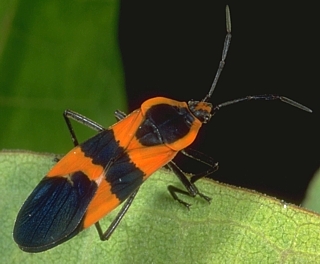 Large
Milkweed Bug, Oncopeltus fasciatus (R. Bessin, 2001)
Large
Milkweed Bug, Oncopeltus fasciatus (R. Bessin, 2001) |
|
|
|
LONG-NECKED
SEED BUG
FAMILY: Rhyparochromidae
| GENUS
and SPECIES:
Myodocha serripes
The family Rhyparochromidae
contains the only "true" seed bugs. The most well-known
species in Rhyparochromidae is the Long-Necked Seed Bug,
Myodocha serripes. This distinctive seed bug is very
common in gardens, lawns, and agricultural habitats in Kentucky.
It is about 3/8" long. |
| |
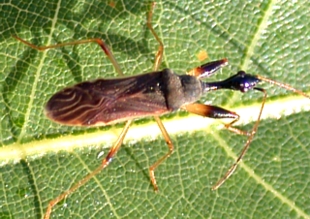 Long-necked
seed bug (B. Newton, 2006)
Long-necked
seed bug (B. Newton, 2006) |
|
|
|
CHINCH
BUG
FAMILY: Blissidae
| GENUS and SPECIES: Blissus leucopterus
The Chinch Bug,
Blissus leucopterus, is a small (1/4") insect that
feeds on grasses, including lawn grasses, corn, and related plants
like wheat. It is sometimes a serious pest, as mentioned above
in the Pest Status section. It is the
most well-known member of the family Blissidae. Other members
of this family have a resemblance to the chinch bug, although some
species are larger. |
| |
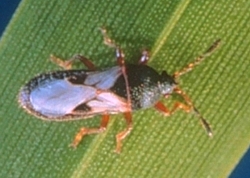 Chinch
Bug, Blissus leucopterus
(Image courtesy USDA Photo Set)
Chinch
Bug, Blissus leucopterus
(Image courtesy USDA Photo Set) |
|
|
|
PACHYGRONTHIDS
FAMILY: Pachygronthidae
| GENUS:
Oedancala
The bugs in the genus
Oedancala may be the most frequently encountered insects
from the family Pachygronthidae that occur in Kentucky. The one pictured below is
probably Oedancala dorsali, and it was about 1/4" long. Little is known about this bug (or
others in the family), but it is sometimes found in moist, low areas
where it is believed to feed on the seed heads of grasses and sedges. |
| |
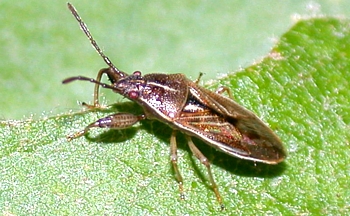 Pachygronthid
bug in the Oedancala genus (B. Newton, 2005)
Pachygronthid
bug in the Oedancala genus (B. Newton, 2005) |
|
|
|
BIG-EYED
BUGS
FAMILY: Geocoridae
| GENUS:
Geocoris
Pictured below is Geocoris
punctipes. It may be the most commonly encountered member
of the predatory Big-Eyed Bug family (Geocoridae) in Kentucky. It
is found in agricultural crops, gardens, and weedy areas where it
preys on small insects and insect eggs. It is a little less
than 1/4" long. A related big-eyed bug, Geocoris
uliginosis, is also common in Kentucky. It resembles
G. punctipes, but it is generally a little smaller and
darker in color. Many big-eyed bug species are important predators
of crop and garden pests.
|
| |
 Big-Eyed
Bug, Geocoris punctipes (R. Bessin, 2001)
Big-Eyed
Bug, Geocoris punctipes (R. Bessin, 2001) |
|
|
|
STILT
BUGS
FAMILY: Berytidae
Stilt Bugs
have a distinctive appearance, with long, thread-like legs and antennae.
The stilt bug pictured below belongs to the genus Jalysus.
There are several species in this genus, and all are nearly
identical in appearance and they are found in the same habitats.
They can be found feeding on tomatoes, tobacco, gourds, and
related plants, although they do not cause significant damage and
are not considered pests. A few stilt bugs may also be partly
predatory. Note that the stilt bug family, Berytidae, is the
only family on this page whose members were not once a part of the
family Lygaeidae.
|
| |
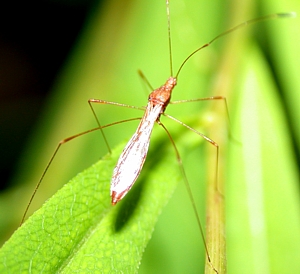 Stilt
Bug, Jalysus sp. (B. Newton, 2005)
Stilt
Bug, Jalysus sp. (B. Newton, 2005) |
|
| |
| COLLECTING
& PHOTOGRAPHY |
|
Although lygaeoids
are fairly common, they are sometimes difficult to find, especially
species with brown or gray color patterns. Look for them in
think, sunny vegetation. Lygaeoids can almost always be captured
in a sweep net when used on a hot day in sunny, low-growing plants.
Large and small milkweed bugs are common and easy to find
on milkweed plants. Stilt bugs are common on tobacco and tomato
plants in the summer.
Although most adult lygaeoids
are able to fly, and can run quickly at times, they will usually
remain still long enough to snap a picture as long as they are not
disturbed, especially on a summer morning before the heat of the
day arrives. Milkweed bugs, in particular, will often remain
still as long as they are not touched. |
| |
| LYGAEOID
FACTS |
|
Before it was broken
into several families, the seed bug family Lygaeidae had the second-most
number of species in the order Hemiptera. The plant
bug family, Miridae, has the most species. |
| |
| MYTHS
- LEGENDS - FOLKLORE |
|
Do you know any myths,
legends, or folklore about seed bugs and their kin? Let us
know if you do! |
| |
Original document: 4 Aug 2006
Last updated: 23 May 2007
Photos courtesy R.
Bessin and B. Newton, University of Kentucky, except Chinch Bug, USDA
Photo Set; used with permission
The Kentucky Critter Files are maintained by Blake Newton, Department
of Entomology, University of Kentucky.
Contact: blaken@uky.edu |
|

